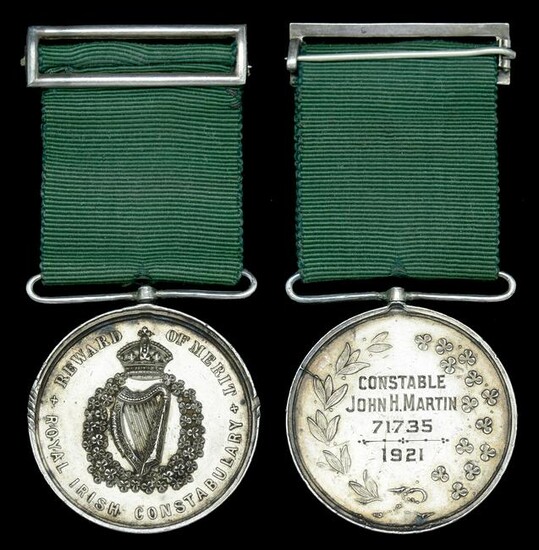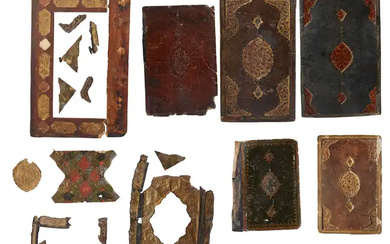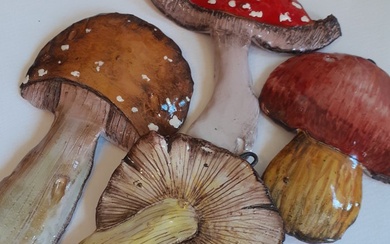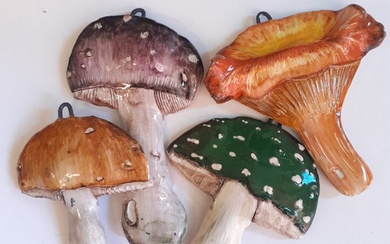Groups and Single Decorations for Gallantry
A 1921 Constabulary Medal (Ireland) awarded to Constable J. H. Martin, Royal Irish Constabulary, for gallantry on operations in West County Kerry in 1921, in particular during an I.R.A. ambush at the Connor Pass near Dingle on 26 FebruaryConstabulary Medal (Ireland), 2nd type, ‘Reward of Merit Royal Irish Constabulary’ (Constable John H. Martin 71735. 1921) with integral top silver riband bar, test marks to edge and minor edge bruising, very fine £2,200-£2,600---Medal authorised on 15 October 1921.John Henry Martin was born in Tavistock, Cornwall on 17 August 1892, the son of a labourer. Although he was of military age when the First World War broke out, he did not join up immediately. His Marriage Certificate (dated June 1915) describes him as a Police Constable living in Torquay, Devon. Service in a Police Force was a Reserved Occupation, which exempted a man from conscription unless he was dismissed or resigned (and the resignation was accepted). It appears that he enlisted in the Devonshire Regiment on 21 March 1918, did not serve overseas, was discharged due to sickness on 4 April 1919 and was issued with Silver War Badge No 509114.Martin joined the Royal Irish Constabulary at the age of 27, on 25 June 1920. He described himself as a labourer and an ex-soldier. After just a few weeks of R.I.C. police training, he was assigned to serve in County Kerry from 17 July 1920.Irish Republicans had long recognised that ‘The R.I.C. were the eyes of the British army’ and since 1916 they had mounted a steadily increasing campaign of intimidation, ostracism and then violence to diminish the R.I.C.’s ability to recruit and retain manpower and to break its morale, especially in rural areas. Recruitment dropped steadily in 1919 and 1920, and resignations and requests for retirement climbed. The smaller R.I.C. posts, usually composed of a handful of men in a rented house without any fortifications, had become sitting ducks for Republican attacks. On 9 November 1919, orders were issued to abandon as many stations as were needed to bring the remainder up to a minimum of six men (later increased to over 10). However, increasing concentration could not stop the haemorrhaging of numbers, and R.I.C. recruiting remained 20-30% or more below the level needed to replace retirements and resignations. On 27 December 1919, the R.I.C. Inspector-General authorised the recruitment of ex-servicemen on the British mainland. The first men recruited as a result appeared in the R.I.C. General Register six days later. For reasons of expediency and economy, Martin and the other mainland recruits were initially issued with both black-green R.I.C. uniform items and with war-surplus military khaki tunics, trousers and coats. They wore these in varying combinations, the most popular being R.I.C. cap, tunic and belt with khaki trousers and coat. This mix ’n match look caused them to be dubbed ‘Black and Tans.’Martin’s service record states that he was recommended by the R.I.C.'s chief recruiting officer in Great Britain, R.I.C. District Inspector and Irish Guards Major Cyril Fleming, who worked in the army recruiting office at Great Scotland Yard in London. Martin met the R.I.C. requirements: his height of six feet one inch was above the pre-war standard of five feet nine inches and he had an Army rating of ‘Good’ or better. The R.I.C. preferred to recruit unmarried men, but made an exception in his case. Tans like Martin were permanent members of the R.I.C. (though they are often confused with the ‘Temporary Constables’ or ‘Temporary Cadets’ who formed separate branches of the security forces). They lived and worked alongside their Irish colleagues, although their accents, religion and multi-coloured uniforms set them apart. Their lack of police training meant that they tended to be assigned a greater share of quasi-military tasks such as raids, searches, guard or escort duties.The R.I.C. Nominal Returns by County for 1920 note that Martin was stationed at Dingle, an isolated garrison in the far west of County Kerry. The incident for which he was awarded the Constabulary Medal was reported in the local newspaper The Liberator of 1 March 1921:‘About 7:30 p.m. last Saturday evening [26 February], a party of seven constables with Head Constable Maguire and District Inspector Captain Hamilton were ambushed at Coumcaoch on the Connor Hill road between Cloghand and Dingle. At this point, which is about 4 miles from Dingle, perpendicular cliffs hundreds of feet in height overhang the road, while from the other side a valley hundreds of feet in depth, abruptly descends. On the night in question the police, who were cycling at the time on their way to Dingle, were met by a hail of bullets from the cliffs overhead. The police at once dismounted, abandoned their bicycles on the roadside, and took cover behind the rocks. It was quite dark, especially in the shadow of the mountain, and to this fact the police owe their miraculous escape. Head Constable Maguire was somewhat severely wounded in the stomach, and Constables Stalford and Ganders sustained slight wounds. The attacking party, which was very strong, secured possession of one rifle as well as the bicycles. They escaped uninjured. A relief party from Dingle barracks, on hearing of the ambush, proceeded to the place and brought in their wounded comrades.’Coum CaocThe I.R.A. perspective on the ambush is contained in several accounts by members of the ambushing force. Witness Statement 1,079 by Patrick Fitzgerald states: ‘Tadhg Brosnan got a local girl to write to the District Inspector, R.I.C. Dingle, to inform him that a Sinn Féin Court was about to be held at Ballyduff Schoolhouse… The object of the letter was to draw the Tans to Ballyduff on a certain day, where an ambush had been prepared… The strength of the attacking party was about 50 men, six of whom had rifles while the remainder had shotguns. The position chosen was [among large boulders on the steep slope of] the high ground on one side of the road at a place called Coum Caoc (the crooked bend) on Connor Pass... The Tans were conveyed from Dingle by lorry. The lorry pulled up at the peak of the pass about half a mile from the ambush position... The Tans dismounted, taking with them a number of bikes off the lorry. Having mounted the bikes they proceeded to cycle into the ambush position. The lorry with machine gun mounted remained at the top of the pass in charge of about three Tans. I, with three or four men, was located about 30 yards from the roadside. My instructions from Brosnan, who was in charge, was to open fire on the patrol in the first instance as it passed my position. When I looked out I saw two Tans pushing their bikes about 200 yards behind the main cycle patrol. At the same time I observed the machine gun mounted on the lorry directly above me... My reason for not opening fire was that I anticipated that the full patrol, once they reached the schoolhouse, would have to return again when we would be able to ambush them in a more compact body. [The cyclist patrol] proceeded to the schoolhouse which they raided, as well as the house and forge of an I.R.A. man named Sean Brosnan. Having done so, they proceeded to Castlegregory, about eight miles from the schoolhouse, where they went to the railway station with the object of procuring a train back to Dingle. As it happened, the train which they meant to catch had already left. After their visit to the station they spent five or six hours around Castlegregory. In the meantime, our scouts were active and kept us informed of the position. As the patrol was raiding the schoolhouse, the lorry, with machine gun, reversed and returned to Dingle. At last our scouts informed us that the patrol were about to leave Castlegregory and were about to return to Dingle the same way as they had come. It was now very dark as the patrol appeared, coming towards the ambush position pushing their bikes. As they approached all I could see was the glow of cigarettes which they were smoking. This being my only target, I, as instructed, gave the order 'open fire'. I and the men with me opened fire to which the Tans replied. Immediately firing became general. After about a quarter of an hour the Tans broke off the engagement.’Further Witness Statements state: ‘The R.I.C. jumped the low fence on the side of the road and made down the mountain leaving nine bicycles behind. They made their way down the mountain side and crossed a river to Mullagh Bheal. The manner of their escape cannot be understood locally, because even people born and reared in the district would hardly risk travelling down the mountain side in daylight... How they were not killed I cannot understand because the road across the Pass is cut into the side of a steep hill.’Not all of the R.I.C. men made the perilous descent down the cliff. Having found some reasonable cover just below the road, the three wounded men and several of their colleagues stayed in place, awaiting assistance, while District Inspector Captain Hamilton led the party who descended the cliffs to locate either a telephone or a vehicle to get a message to Dingle R.I.C. barracks requesting urgent help. The I.R.A. contented themselves with collecting the equipment left on the road and then standing down, rather than conducting a night-time pursuit over challenging terrain.The recommendation for the award of the eleven Constabulary Medals authorised on 15 October has not yet been traced, but it may have included many of the men who were involved in several incidents that occurred near Dingle in February- March 1921. These included the action at Lispole on March 22, where an ambush laid by the I.R.A. was itself ambushed by two Crossley tenders of R.I.C. men from Dingle; three I.R.A. gunmen were mortally wounded.Martin served in Kerry until the R.I.C. was disbanded in 1922. He died in Torquay in 1963. Sold with copied...
[ translate ]View it on
Estimate
Time, Location
Auction House
A 1921 Constabulary Medal (Ireland) awarded to Constable J. H. Martin, Royal Irish Constabulary, for gallantry on operations in West County Kerry in 1921, in particular during an I.R.A. ambush at the Connor Pass near Dingle on 26 FebruaryConstabulary Medal (Ireland), 2nd type, ‘Reward of Merit Royal Irish Constabulary’ (Constable John H. Martin 71735. 1921) with integral top silver riband bar, test marks to edge and minor edge bruising, very fine £2,200-£2,600---Medal authorised on 15 October 1921.John Henry Martin was born in Tavistock, Cornwall on 17 August 1892, the son of a labourer. Although he was of military age when the First World War broke out, he did not join up immediately. His Marriage Certificate (dated June 1915) describes him as a Police Constable living in Torquay, Devon. Service in a Police Force was a Reserved Occupation, which exempted a man from conscription unless he was dismissed or resigned (and the resignation was accepted). It appears that he enlisted in the Devonshire Regiment on 21 March 1918, did not serve overseas, was discharged due to sickness on 4 April 1919 and was issued with Silver War Badge No 509114.Martin joined the Royal Irish Constabulary at the age of 27, on 25 June 1920. He described himself as a labourer and an ex-soldier. After just a few weeks of R.I.C. police training, he was assigned to serve in County Kerry from 17 July 1920.Irish Republicans had long recognised that ‘The R.I.C. were the eyes of the British army’ and since 1916 they had mounted a steadily increasing campaign of intimidation, ostracism and then violence to diminish the R.I.C.’s ability to recruit and retain manpower and to break its morale, especially in rural areas. Recruitment dropped steadily in 1919 and 1920, and resignations and requests for retirement climbed. The smaller R.I.C. posts, usually composed of a handful of men in a rented house without any fortifications, had become sitting ducks for Republican attacks. On 9 November 1919, orders were issued to abandon as many stations as were needed to bring the remainder up to a minimum of six men (later increased to over 10). However, increasing concentration could not stop the haemorrhaging of numbers, and R.I.C. recruiting remained 20-30% or more below the level needed to replace retirements and resignations. On 27 December 1919, the R.I.C. Inspector-General authorised the recruitment of ex-servicemen on the British mainland. The first men recruited as a result appeared in the R.I.C. General Register six days later. For reasons of expediency and economy, Martin and the other mainland recruits were initially issued with both black-green R.I.C. uniform items and with war-surplus military khaki tunics, trousers and coats. They wore these in varying combinations, the most popular being R.I.C. cap, tunic and belt with khaki trousers and coat. This mix ’n match look caused them to be dubbed ‘Black and Tans.’Martin’s service record states that he was recommended by the R.I.C.'s chief recruiting officer in Great Britain, R.I.C. District Inspector and Irish Guards Major Cyril Fleming, who worked in the army recruiting office at Great Scotland Yard in London. Martin met the R.I.C. requirements: his height of six feet one inch was above the pre-war standard of five feet nine inches and he had an Army rating of ‘Good’ or better. The R.I.C. preferred to recruit unmarried men, but made an exception in his case. Tans like Martin were permanent members of the R.I.C. (though they are often confused with the ‘Temporary Constables’ or ‘Temporary Cadets’ who formed separate branches of the security forces). They lived and worked alongside their Irish colleagues, although their accents, religion and multi-coloured uniforms set them apart. Their lack of police training meant that they tended to be assigned a greater share of quasi-military tasks such as raids, searches, guard or escort duties.The R.I.C. Nominal Returns by County for 1920 note that Martin was stationed at Dingle, an isolated garrison in the far west of County Kerry. The incident for which he was awarded the Constabulary Medal was reported in the local newspaper The Liberator of 1 March 1921:‘About 7:30 p.m. last Saturday evening [26 February], a party of seven constables with Head Constable Maguire and District Inspector Captain Hamilton were ambushed at Coumcaoch on the Connor Hill road between Cloghand and Dingle. At this point, which is about 4 miles from Dingle, perpendicular cliffs hundreds of feet in height overhang the road, while from the other side a valley hundreds of feet in depth, abruptly descends. On the night in question the police, who were cycling at the time on their way to Dingle, were met by a hail of bullets from the cliffs overhead. The police at once dismounted, abandoned their bicycles on the roadside, and took cover behind the rocks. It was quite dark, especially in the shadow of the mountain, and to this fact the police owe their miraculous escape. Head Constable Maguire was somewhat severely wounded in the stomach, and Constables Stalford and Ganders sustained slight wounds. The attacking party, which was very strong, secured possession of one rifle as well as the bicycles. They escaped uninjured. A relief party from Dingle barracks, on hearing of the ambush, proceeded to the place and brought in their wounded comrades.’Coum CaocThe I.R.A. perspective on the ambush is contained in several accounts by members of the ambushing force. Witness Statement 1,079 by Patrick Fitzgerald states: ‘Tadhg Brosnan got a local girl to write to the District Inspector, R.I.C. Dingle, to inform him that a Sinn Féin Court was about to be held at Ballyduff Schoolhouse… The object of the letter was to draw the Tans to Ballyduff on a certain day, where an ambush had been prepared… The strength of the attacking party was about 50 men, six of whom had rifles while the remainder had shotguns. The position chosen was [among large boulders on the steep slope of] the high ground on one side of the road at a place called Coum Caoc (the crooked bend) on Connor Pass... The Tans were conveyed from Dingle by lorry. The lorry pulled up at the peak of the pass about half a mile from the ambush position... The Tans dismounted, taking with them a number of bikes off the lorry. Having mounted the bikes they proceeded to cycle into the ambush position. The lorry with machine gun mounted remained at the top of the pass in charge of about three Tans. I, with three or four men, was located about 30 yards from the roadside. My instructions from Brosnan, who was in charge, was to open fire on the patrol in the first instance as it passed my position. When I looked out I saw two Tans pushing their bikes about 200 yards behind the main cycle patrol. At the same time I observed the machine gun mounted on the lorry directly above me... My reason for not opening fire was that I anticipated that the full patrol, once they reached the schoolhouse, would have to return again when we would be able to ambush them in a more compact body. [The cyclist patrol] proceeded to the schoolhouse which they raided, as well as the house and forge of an I.R.A. man named Sean Brosnan. Having done so, they proceeded to Castlegregory, about eight miles from the schoolhouse, where they went to the railway station with the object of procuring a train back to Dingle. As it happened, the train which they meant to catch had already left. After their visit to the station they spent five or six hours around Castlegregory. In the meantime, our scouts were active and kept us informed of the position. As the patrol was raiding the schoolhouse, the lorry, with machine gun, reversed and returned to Dingle. At last our scouts informed us that the patrol were about to leave Castlegregory and were about to return to Dingle the same way as they had come. It was now very dark as the patrol appeared, coming towards the ambush position pushing their bikes. As they approached all I could see was the glow of cigarettes which they were smoking. This being my only target, I, as instructed, gave the order 'open fire'. I and the men with me opened fire to which the Tans replied. Immediately firing became general. After about a quarter of an hour the Tans broke off the engagement.’Further Witness Statements state: ‘The R.I.C. jumped the low fence on the side of the road and made down the mountain leaving nine bicycles behind. They made their way down the mountain side and crossed a river to Mullagh Bheal. The manner of their escape cannot be understood locally, because even people born and reared in the district would hardly risk travelling down the mountain side in daylight... How they were not killed I cannot understand because the road across the Pass is cut into the side of a steep hill.’Not all of the R.I.C. men made the perilous descent down the cliff. Having found some reasonable cover just below the road, the three wounded men and several of their colleagues stayed in place, awaiting assistance, while District Inspector Captain Hamilton led the party who descended the cliffs to locate either a telephone or a vehicle to get a message to Dingle R.I.C. barracks requesting urgent help. The I.R.A. contented themselves with collecting the equipment left on the road and then standing down, rather than conducting a night-time pursuit over challenging terrain.The recommendation for the award of the eleven Constabulary Medals authorised on 15 October has not yet been traced, but it may have included many of the men who were involved in several incidents that occurred near Dingle in February- March 1921. These included the action at Lispole on March 22, where an ambush laid by the I.R.A. was itself ambushed by two Crossley tenders of R.I.C. men from Dingle; three I.R.A. gunmen were mortally wounded.Martin served in Kerry until the R.I.C. was disbanded in 1922. He died in Torquay in 1963. Sold with copied...
[ translate ]





